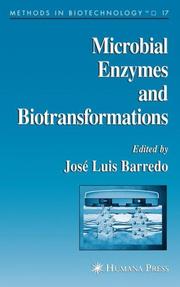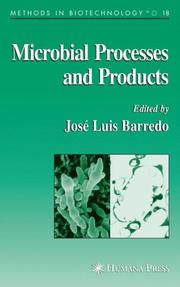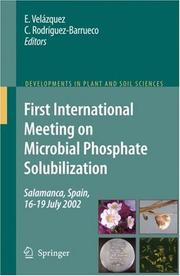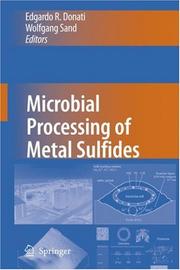| Listing 1 - 10 of 12 | << page >> |
Sort by
|
Periodical
ISSN: 15730972 09593993 Year: 1990 Publisher: [Oxford] : Rapid Science Publishers
Abstract | Keywords | Export | Availability | Bookmark
 Loading...
Loading...Choose an application
- Reference Manager
- EndNote
- RefWorks (Direct export to RefWorks)
Industrial microbiology --- Microbial biotechnology --- Biotechnology --- Microbiology --- Microbiologie industrielle --- Biotechnologie microbienne --- Microorganisms --- Industrial applications --- Biotechnological microorganisms

ISBN: 1588292533 9786610359660 1280359668 1592598463 Year: 2005 Publisher: Clifton, NJ : Humana Press,
Abstract | Keywords | Export | Availability | Bookmark
 Loading...
Loading...Choose an application
- Reference Manager
- EndNote
- RefWorks (Direct export to RefWorks)
The application of recombinant DNA technology to industrial fermentation and the production of enzymes over the last 20 years has produced a host of useful chemical and biochemical substances. In Microbial Enzymes and Biotransformations, leading experts in enzyme manipulation describe in detail their cutting-edge techniques for the screening, evolution, production, immobilization, and application of enzymes. These readily reproducible methods can be used to improve enzyme function by directed evolution, to covalently immobilize enzymes, to microencapsulate enzymes and cells, and to manufacture enzymes for human health, nutrition, and environmental protection. Two overview chapters consider microorganisms as a source of metabolic and enzymatic diversity, and enzymes in the fast-moving field of enzyme biosensors. The protocols follow the successful Methods in Biotechnology™ series format, each offering step-by-step laboratory instructions, an introduction outlining the principle behind the technique, lists of the necessary equipment and reagents, and tips on troubleshooting and avoiding known pitfalls. A companion volume, Microbial Processes and Products, provides laboratory procedures for a wide range of processes and products mediated by microorganisms. Comprehensive and highly practical, Microbial Enzymes and Biotransformations offers laboratory and industrial scientists a wealth of proven enzymatic protocols that show clearly how to go from laboratory results to successful industrial applications.
Microbial enzymes --- Microbial biotechnology --- Biotransformation (Metabolism) --- Biotechnology --- Biotransformation (Metabolism) -- Laboratory manuals. --- Microbial biotechnology -- Laboratory manuals. --- Microbial enzymes -- Biotechnology -- Laboratory manuals. --- Biotransformation --- Activation, Metabolic --- Metabolic activation --- Microorganisms --- Industrial microbiology --- Biotechnological microorganisms --- Bioactivation (Metabolism) --- Biodegradation (Metabolism) --- Metabolism --- Pharmacology --- Microbiology. --- Microbial biology --- Biology
Book
ISBN: 1402082916 9048178339 9786612236624 1282236628 1402082924 Year: 2008 Publisher: Dordrecht ; London : Springer,
Abstract | Keywords | Export | Availability | Bookmark
 Loading...
Loading...Choose an application
- Reference Manager
- EndNote
- RefWorks (Direct export to RefWorks)
I belie ve that the book would provide an overview of the recent developments in the domain of yeast research with some new ideas, which could serve as an inspiration and challenge for researchers in this field. Ne w Delhi Prof. Asis Datta Dec. 24, 2007 Former Vice-chancellor, JNU Director, NCPGR (New Delhi) Preface Yeasts are eukaryotic unicellular microfungi that are widely distributed in the natural environments. Although yeasts are not as ubiquitous as bacteria in the natural environments, they have been isolated from terrestrial, aquatic and atmospheric environments. Yeast communities have been found in association with plants, animals and insects. Several species of yeasts have also been isolated from specialized or extreme environments like those with low water potential (e. g. high sugar/salt concentrations), low temperature (e. g. yeasts isolated from Antarctica), and low oxygen availability (e. g. intestinal tracts of animals). Around 1500 species of yeasts belonging to over 100 genera have been described so far. It is estimated that only 1% of the extant yeasts on earth have been described till date. Therefore, global efforts are underway to recover new yeast species from a variety of normal and extreme environments. Yeasts play an important role in food chains, and carbon, nitrogen and sulphur cycles. Yeasts can be genetically manipulated by hybridization, mutation, rare m- ing, cytoduction, spheroplast fusion, single chromosomal transfer and transformation using recombinant technology. Yeasts (e. g.
Yeast fungi --- Microbial biotechnology. --- Microorganisms --- Yeast --- Yeast biotechnology --- Biotechnology. --- Biotechnology --- Chemistry. --- Microbiology. --- Applied Microbiology. --- Industrial microbiology --- Biotechnological microorganisms --- Microbial biotechnology --- Yeast industry --- Microbial biology --- Biology --- Chemical engineering --- Genetic engineering

ISBN: 1588295486 9781588295484 9781592598472 9786610359653 128035965X 1592598471 Year: 2005 Volume: 18 Publisher: Totowa, NJ Humana Press :Imprint: Humana
Abstract | Keywords | Export | Availability | Bookmark
 Loading...
Loading...Choose an application
- Reference Manager
- EndNote
- RefWorks (Direct export to RefWorks)
The development of recombinant DNA techniques over the last 20 years has greatly expanded the opportunities for using microorganisms to produce a broad range of valuable substances. In Microbial Processes and Products, outstanding leaders in using microorganisms as cell factories describe in detail their best laboratory procedures for many processes and products mediated by microorganisms. An overview chapter describes how to develop strain improvement programs and strategies to optimize fermentation processes. Taking advantage of the most recent developments in such processes, the authors offer step-by-step experimental methods for the optimal design of microbial metabolite production, including semisynthetic derivatives of cephalosporins, erythromycin, antitumor compounds, plasmids for gene therapy and DNA vaccination, L-lysine, vitamins B2 and B12, the sweet-tasting protein thaumatin, the carotenoids b-carotene and astaxanthin, the polysaccharide gellan, and bacteria-producing bacteria for sausage fermentation. Additionally, the use of phenylacetyl-CoA catabolon for enzymatic synthesis of penicillins, aromatic biotransformations, synthesis of new bioplastics, biosensor design, or synthesis of drug vehicles, and the development of a phosphate encoding gene as a reporter and to monitor gene expression are illustrated. The diverse chemicals and biochemicals produced can be used in human health, nutrition, and environmental protection. Additional chapters offer techniques for analysis of antimicrobial metabolites and carotenoids, volatile sulfur compounds, metabolic pathway fluxes, gene expression arrays, proteome analysis, bacterial modulation of the innate immune response, bioleaching activity, and heavy metal remediation. Finally, three overview chapters on transport of biological material, deposit of biological material for patent purposes, and protection of biotechnological inventions are shown. The protocols follow the successful Methods in Biotechnology™ series format, each offering step-by-step laboratory instructions, an introduction outlining the principle behind the technique, lists of the necessary equipment and reagents, and tips on troubleshooting and avoiding known pitfalls. A companion volume, Microbial Enzymes and Biotransformations, describes in detail cutting-edge techniques for the screening, evolution, production, immobilization, and use of enzymes. Wide-ranging and practical, Microbial Processes and Products offers laboratory and industrial scientists a wealth of readily reproducible techniques for the successful microbial generation of biochemical products to serve the needs of human health, nutrition, and environmental protection.
biotechnologie --- recombinant DNA --- micro-organismen --- Biotechnology --- Microbial biotechnology --- Industrial Microbiology --- Methodology --- methods --- Biotechnology. --- Electronic books. -- local. --- Microbial biotechnology -- Methodology. --- Microbiology --- Biology --- Technology --- Biological Science Disciplines --- Technology, Industry, and Agriculture --- Natural Science Disciplines --- Technology, Industry, Agriculture --- Disciplines and Occupations --- Bioengineering --- Mechanical Engineering --- Engineering & Applied Sciences --- Methodology. --- Microorganisms --- Industrial microbiology --- Biotechnological microorganisms --- Chemical engineering --- Genetic engineering --- Microbiology. --- Microbial biology

ISBN: 1280864575 9786610864577 1402057652 1402040199 9048170133 Year: 2007 Volume: v. 102 Publisher: Dordrecht : Springer,
Abstract | Keywords | Export | Availability | Bookmark
 Loading...
Loading...Choose an application
- Reference Manager
- EndNote
- RefWorks (Direct export to RefWorks)
Last decade has seen a significantly increased knowledge about phosphate solubilizing microorganisms. Sixty specialists from thirteen countries met in Salamanca to discuss the problems of the high P-unavailability as a soil nutrient for crops, and the hazards of an increasing phosphate input to aquatic habitats from industrial and mining activities, sewage disposal, detergents, and other sources. Updated solutions to enhance P-uptake by plants, bioremediation potential in the rehabilitation of ecosystems, taxonomic characterization interactions with mycorrizae, the physiological and molecular basis of PSM, and possibilities of genetic modifications of rhizospheric microorganisms were among the contributions presented. Challenges in commercializing a phosphate solubilizing microorganism were also outlined by a relevant biotech company. The book will fill a gap in agricultural libraries and it is a wish of the editors to attract the attention of agronomists, environmentalist, technocrats and administrators holding responsibilities in the field of soil conservation and sustainable agricultural production.
Phosphates --- Microorganisms --- Soil fertility --- Microbial biotechnology --- Solubilization --- Soil science --- Solubility --- Biotechnology --- Industrial microbiology --- Biotechnological microorganisms --- Germs --- Micro-organisms --- Microbes --- Microscopic organisms --- Organisms --- Microbiology --- Bone products --- Agriculture. --- Sedimentology. --- Microbiology. --- Microbial ecology. --- Biodiversity. --- Biotechnology. --- Microbial Ecology. --- Environmental Engineering/Biotechnology. --- Chemical engineering --- Genetic engineering --- Biological diversification --- Biological diversity --- Biotic diversity --- Diversification, Biological --- Diversity, Biological --- Biology --- Biocomplexity --- Ecological heterogeneity --- Numbers of species --- Environmental microbiology --- Ecology --- Microbial biology --- Petrology --- Farming --- Husbandry --- Industrial arts --- Life sciences --- Food supply --- Land use, Rural --- Environmental engineering. --- Environmental control --- Environmental effects --- Environmental stresses --- Engineering --- Environmental health --- Environmental protection --- Pollution --- Sustainable engineering --- Microbial phosphate solubilization --- MPS

ISBN: 1280865199 9786610865192 1402055897 1402055889 9048174023 9781402055881 9781402055898 Year: 2007 Publisher: Dordrecht : Springer,
Abstract | Keywords | Export | Availability | Bookmark
 Loading...
Loading...Choose an application
- Reference Manager
- EndNote
- RefWorks (Direct export to RefWorks)
The application of microbiological methods to the extraction of metals from minerals has definitely gained a prominent role and is supported by the several bioleaching and biooxidation processes operating in different sites over the world. In recent years new techniques and new results about proteomic and bioinformatics are bringing a new perspective on the microbial processes. This book focuses on the basic aspects of the process with special emphasis on recent contributions regarding the chemical and microbial aspects of the bioleaching process and the use of microorganisms in the treatment of complex ores and concentrates. It has been written by recognized researchers in order to introduce the main subjects of microbial processing to undergraduate and postgraduate students, scientists working in this field as well as interested industrialists.
Sulfides --- Minerals --- Microbial biotechnology. --- Metallurgy. --- Biotechnology. --- Microorganisms --- Biotechnology --- Industrial microbiology --- Biotechnological microorganisms --- Biomining --- Mineral bioprocessing --- Mineral biotechnology --- Metallurgy --- Mining engineering --- Materials. --- Microbiology. --- Biochemical engineering. --- Mineral resources. --- Bioinformatics. --- Microbial ecology. --- Metallic Materials. --- Applied Microbiology. --- Biochemical Engineering. --- Mineral Resources. --- Microbial Ecology. --- Bio-informatics --- Biological informatics --- Biology --- Information science --- Computational biology --- Systems biology --- Deposits, Mineral --- Mineral deposits --- Mineral resources --- Mines and mining --- Mining --- Natural resources --- Geology, Economic --- Bio-process engineering --- Bioprocess engineering --- Biochemistry --- Chemical engineering --- Environmental microbiology --- Ecology --- Microbiology --- Microbial biology --- Engineering --- Engineering materials --- Industrial materials --- Engineering design --- Manufacturing processes --- Data processing --- Materials --- Metals. --- Metallic elements --- Chemical elements --- Ores --- Sulfures (minéralogie) --- Minéraux --- Microorganismes --- Biotechnologie
Periodical
Abstract | Keywords | Export | Availability | Bookmark
 Loading...
Loading...Choose an application
- Reference Manager
- EndNote
- RefWorks (Direct export to RefWorks)
Histology. Cytology --- Microbial biotechnology --- Recombinant proteins --- Cells --- Recombinant Proteins --- Cell Culture --- Genetics, Microbial --- Biotechnology --- Biotechnologie microbienne --- Protéines recombinantes --- Periodicals --- Synthesis --- microbiology --- Periodicals. --- utilization --- Périodiques --- Synthèse --- Microbial biotechnology. --- Synthesis. --- Recombinant Proteins. --- Culture Techniques --- Genetics, Microbial. --- Biotechnology. --- microbiology. --- utilization. --- Microbial Genetics --- Genetic, Microbial --- Microbial Genetic --- Proteins, Biosynthetic --- Proteins, Recombinant DNA --- Biosynthetic Proteins --- DNA Recombinant Proteins --- DNA Proteins, Recombinant --- Proteins, DNA Recombinant --- Proteins, Recombinant --- Recombinant DNA Proteins --- Recombinant Proteins, DNA --- Genetically engineered proteins --- Proteins --- Microorganisms --- Biotechnologies --- Genetic engineering --- applied microbiology --- Virus Physiological Phenomena --- Bacterial Physiological Phenomena --- Genome, Microbial --- Bioreactors --- Recombinant molecules --- Industrial microbiology --- Biotechnological microorganisms --- Histology. --- Microbiology. --- Culture Technique --- Technique, Culture --- Techniques, Culture --- Diffusion Chambers, Culture --- General microbiology --- statistics & numerical data. --- Bioengineering --- Biosynthetic Protein --- Recombinant Protein --- Protein, Biosynthetic --- Protein, Recombinant --- Biotecnologia microbiana --- Genètica microbiana --- Proteïnes recombinants
Periodical
ISSN: 09741275 09717811 Year: 1992 Publisher: New Delhi : Berlin : Society for Plant Biochemistry and Biotechnology, Indian Agricultural Research Institute, Springer
Abstract | Keywords | Export | Availability | Bookmark
 Loading...
Loading...Choose an application
- Reference Manager
- EndNote
- RefWorks (Direct export to RefWorks)
Plant biotechnology --- Botanical chemistry --- Microbial biotechnology --- Biochemistry --- Genetic Engineering --- Genetics, Microbial --- Molecular Biology --- Plants --- Recombinant Proteins --- genetics --- Proteins, Biosynthetic --- Proteins, Recombinant DNA --- Biosynthetic Proteins --- DNA Recombinant Proteins --- DNA Proteins, Recombinant --- Proteins, DNA Recombinant --- Proteins, Recombinant --- Recombinant DNA Proteins --- Recombinant Proteins, DNA --- Plant --- Biochemical Genetics --- Biology, Molecular --- Genetics, Biochemical --- Genetics, Molecular --- Molecular Genetics --- Biochemical Genetic --- Genetic, Biochemical --- Genetic, Molecular --- Molecular Genetic --- Microbial Genetics --- Genetic, Microbial --- Microbial Genetic --- Engineering, Genetic --- Intervention, Genetic --- Genetic Intervention --- Genetic Interventions --- Interventions, Genetic --- Microorganisms --- Crop biotechnology --- Crops --- Biotechnology --- Bioreactors --- Botany --- Plant Proteins --- Ethnopharmacology --- Genetic Phenomena --- Virus Physiological Phenomena --- Bacterial Physiological Phenomena --- Genome, Microbial --- Cloning, Molecular --- DNA, Recombinant --- Industrial Microbiology --- Artificial Gene Fusion --- Organisms, Genetically Modified --- Animals, Genetically Modified --- Plants, Genetically Modified --- Industrial microbiology --- Biotechnological microorganisms --- Agricultural biotechnology --- Chemistry --- biotechnologie --- Biosynthetic Protein --- Recombinant Protein --- Protein, Biosynthetic --- Protein, Recombinant --- Biochemistry. --- Genetic Engineering. --- Genetics, Microbial. --- Molecular Biology. --- Plants. --- Recombinant Proteins. --- genetics.
Book
ISBN: 3642089836 354070857X 9786612236198 1282236199 3540708685 Year: 2009 Publisher: Berlin ; London : Springer,
Abstract | Keywords | Export | Availability | Bookmark
 Loading...
Loading...Choose an application
- Reference Manager
- EndNote
- RefWorks (Direct export to RefWorks)
In recent years, plants have been increasingly explored for production of biomedicines and vaccine components. The two main advantages of plant systems are low cost and a greater potential for scalability as compared to microbial or animal systems. An additional advantage from the public health point of view is high safety compared to animal systems, which is important for vaccine production: there are no known plant pathogens capable of replicating in animals, and in humans in particular. A particular antigen or a protein has to be expressed in a plant using one of many available platforms; this antigen/protein subsequently needs to be purified or processed, and later formulated into a vaccine or a therapeutic; these need to be delivered to a human or animal body via an appropriate route. Naturally, all these vaccines and therapeutics must be subjected to regulatory approvals prior to their use. Thus, the challenge is to adapt plant-based platforms for production of cost-efficient biomedicals that can be approved by FDA for use as vaccine components or therapeutics which will be competitive against existing vaccines and drugs. Production of vaccine components and other biomedicals in plants has a great potential in medicine and veterinary science.
Microbial biotechnology. --- Plant biotechnology. --- Protein engineering. --- Vaccines -- Biotechnology. --- Vaccines --- Plant biotechnology --- Microbial biotechnology --- Protein engineering --- Biological Science Disciplines --- Technology --- Eukaryota --- Biological Products --- Organisms --- Complex Mixtures --- Natural Science Disciplines --- Technology, Industry, and Agriculture --- Technology, Industry, Agriculture --- Disciplines and Occupations --- Chemicals and Drugs --- Biotechnology --- Plants --- Health & Biological Sciences --- Biomedical Engineering --- Pharmacy, Therapeutics, & Pharmacology --- Biotechnology. --- Engineering, Protein --- Protein design --- Proteins --- Microorganisms --- Crop biotechnology --- Crops --- Vaccine biotechnology --- Design --- Medicine. --- Medical microbiology. --- Pharmacology. --- Virology. --- Biomedicine. --- Pharmacology/Toxicology. --- Medical Microbiology. --- Microbiology --- Drug effects --- Medical pharmacology --- Medical sciences --- Chemicals --- Chemotherapy --- Drugs --- Pharmacy --- Clinical sciences --- Medical profession --- Human biology --- Life sciences --- Pathology --- Physicians --- Physiological effect --- Biochemical engineering --- Genetic engineering --- Industrial microbiology --- Biotechnological microorganisms --- Agricultural biotechnology --- Toxicology. --- Medical virology. --- Microbiology. --- Medical microbiology --- Virology --- Virus diseases --- Medicine --- Pharmacology --- Poisoning --- Poisons --- Microbial biology --- Biology --- Toxicology
Periodical
ISSN: 19496680 Year: 2005 Publisher: Washington, D.C. : U.S. Dept. of Agriculture, Agricultural Research Service
Abstract | Keywords | Export | Availability | Bookmark
 Loading...
Loading...Choose an application
- Reference Manager
- EndNote
- RefWorks (Direct export to RefWorks)
Microbial biotechnology --- Lignocellulose --- Ethanol as fuel --- Biomass energy --- Renewable energy sources --- Agriculture and energy --- Agriculture and energy. --- Biomass energy. --- Ethanol as fuel. --- Microbial biotechnology. --- Renewable energy sources. --- Industrial applications --- United States. --- Alternate energy sources --- Alternative energy sources --- Energy sources, Renewable --- Sustainable energy sources --- Power resources --- Renewable natural resources --- Microorganisms --- Biotechnology --- Industrial microbiology --- Biotechnological microorganisms --- Ligno-cellulose --- Lignocellulosics --- Cellulose --- Lignin --- Ethanol fuel --- Fuel ethanol --- Fuel --- Bio-energy (Biomass energy) --- Bioenergy (Biomass energy) --- Biofuels --- Biological fuels --- Energy, Biomass --- Microbial energy conversion --- Energy conversion --- Microbial fuel cells --- Refuse as fuel --- Waste products as fuel --- Energy and agriculture --- Energy in agriculture --- Biomass as fuel --- Renewable fuels --- ABŞ --- ABSh --- Ameerika Ühendriigid --- America (Republic) --- Amerika Birlăshmish Shtatlary --- Amerika Birlăşmi Ştatları --- Amerika Birlăşmiş Ştatları --- Amerika ka Kelenyalen Jamanaw --- Amerika Qūrama Shtattary --- Amerika Qŭshma Shtatlari --- Amerika Qushma Shtattary --- Amerika (Republic) --- Amerikai Egyesült Államok --- Amerikanʹ Veĭtʹsėndi͡avks Shtattnė --- Amerikări Pĕrleshu̇llĕ Shtatsem --- Amerikas Forenede Stater --- Amerikayi Miatsʻyal Nahangner --- Ameriketako Estatu Batuak --- Amirika Carékat --- AQSh --- Ar. ha-B. --- Arhab --- Artsot ha-Berit --- Artzois Ha'bris --- Bí-kok --- Ē.P.A. --- É.-U. --- EE.UU. --- Egyesült Államok --- ĒPA --- Estados Unidos --- Estados Unidos da América do Norte --- Estados Unidos de América --- Estaos Xuníos --- Estaos Xuníos d'América --- Estatos Unitos --- Estatos Unitos d'America --- Estats Units d'Amèrica --- Ètats-Unis d'Amèrica --- États-Unis d'Amérique --- ÉU --- Fareyniḳṭe Shṭaṭn --- Feriene Steaten --- Feriene Steaten fan Amearika --- Forente stater --- FS --- Hēnomenai Politeiai Amerikēs --- Hēnōmenes Politeies tēs Amerikēs --- Hiwsisayin Amerikayi Miatsʻeal Tērutʻiwnkʻ --- Istadus Unidus --- Jungtinės Amerikos valstybės --- Mei guo --- Mei-kuo --- Meiguo --- Mî-koet --- Miatsʻyal Nahangner --- Miguk --- Na Stàitean Aonaichte --- NSA --- S.U.A. --- SAD --- Saharat ʻAmērikā --- SASht --- Severo-Amerikanskie Shtaty --- Severo-Amerikanskie Soedinennye Shtaty --- Si͡evero-Amerikanskīe Soedinennye Shtaty --- Sjedinjene Američke Države --- Soedinennye Shtaty Ameriki --- Soedinennye Shtaty Severnoĭ Ameriki --- Soedinennye Shtaty Si͡evernoĭ Ameriki --- Spojené obce severoamerické --- Spojené staty americké --- SShA --- Stadoù-Unanet Amerika --- Stáit Aontaithe Mheiriceá --- Stany Zjednoczone --- Stati Uniti --- Stati Uniti d'America --- Stâts Unîts --- Stâts Unîts di Americhe --- Steatyn Unnaneysit --- Steatyn Unnaneysit America --- SUA --- Sŭedineni amerikanski shtati --- Sŭedinenite shtati --- Tetã peteĩ reko Amérikagua --- U.S. --- U.S.A. --- United States of America --- Unol Daleithiau --- Unol Daleithiau America --- Unuiĝintaj Ŝtatoj de Ameriko --- US --- USA --- Usono --- Vaeinigte Staatn --- Vaeinigte Staatn vo Amerika --- Vereinigte Staaten --- Vereinigte Staaten von Amerika --- Verenigde State van Amerika --- Verenigde Staten --- VS --- VSA --- Wááshindoon Bikéyah Ałhidadiidzooígíí --- Wilāyāt al-Muttaḥidah --- Wilāyāt al-Muttaḥidah al-Amirīkīyah --- Wilāyāt al-Muttaḥidah al-Amrīkīyah --- Yhdysvallat --- Yunaeted Stet --- Yunaeted Stet blong Amerika --- ZDA --- Združene države Amerike --- Zʹi͡ednani Derz͡havy Ameryky --- Zjadnośone staty Ameriki --- Zluchanyi͡a Shtaty Ameryki --- Zlucheni Derz͡havy --- ZSA
| Listing 1 - 10 of 12 | << page >> |
Sort by
|

 Search
Search Feedback
Feedback About UniCat
About UniCat  Help
Help News
News